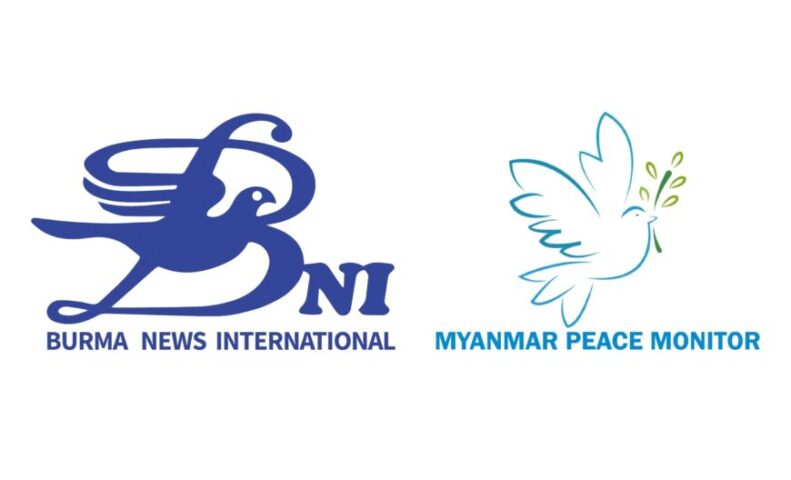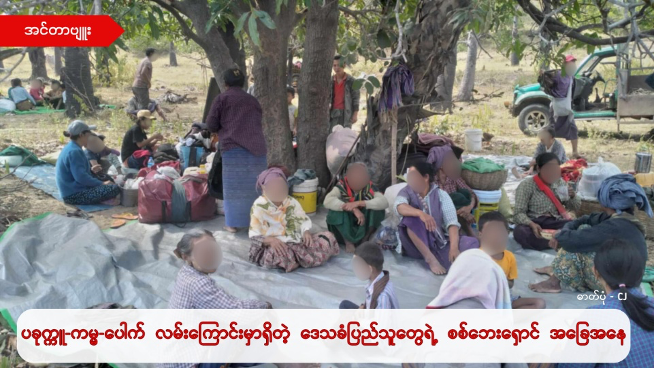An interview with a local IDP aid worker about the situation of dispalced locals on Pakokku-Kanma-Pauk route and their difficulties.
A military column of approximately 800 troops and 120 vehicles that departed from the 101 Division in Pakokku Township, Magway Region, on 28 May remain in Kanma for nearly a month.
The convoys are expected to be deployed to Pyu Saw Htee villages and some weapon factories in Pauk Township.
Than Lwin Times interviewed a person assisting internally displaced persons (IDPs) about the reasons behind the delay in the journey from Kanma to Pauk—which would normally take only four hours—and the hardships local residents along the Pakokku–Kanma–Pauk route are facing due to the presence of the junta’s military column and convoy.
Q: I would like to know the current situation of the convoy that departed from Kanma in Pakokku.
A: The convoy that left Pakokku for Pauk is still between Kanma and Pakokku. It started moving on 24 June.
Q: How long has the convoy been stationed there?
A: The military convoy departed Pakokku on 27 May and arrived in Kanma. On 28 May, it reached Pauk Township. After the military column left, the convoy departed on 29 May but remains in Kanma to this day.
Q: How many clashes have occurred between the convoy and defense forces?
A: There have been four clashes with defense forces.
Q: What were the casualties suffered by the military council in the four battles? Were there any casualties on the side of the defense forces?
A: In the first three incidents, drone strikes and sniper attacks reportedly injured about five soldiers on the military council’s side. The exact number of deaths remains unknown. During a one-hour-long clash, approximately 20 junta soldiers were killed. According to our witness, five of our own were also killed.
Q: Where do you think the convoy is headed?
A: The convoy is heading toward the Defence Industries factories and Pyu Saw Htee villages in Pauk Township. Its main purpose is to deliver food supplies to the Pyu Saw Htee villages, which have been running low on provisions.
Q: Is their journey taking longer than expected?
A: About 80 soldiers were sent to support the convoy. However, during that time, large-scale battles broke out, preventing them from advancing. The troops that had already moved forward were ultimately forced to retreat.
Q: What is the situation regarding civilian casualties due to airstrikes? What is the difference between the military council’s military operations and the prevention of the defense forces last year and this year?
A: In previous years, they used to send supplies about once every six months or five months. At the very least, they would send something every four to six months. Now they use military columns weren’t used just occasionally — now they’re being used repeatedly and frequently. That’s a significant difference from before. In areas where military columns are present, they’re now being used continuously on a daily basis. That kind of sustained activity is unusual.
Q: What is the extent of casualties among the IDPs?
A: So far, about 40 civilians were injured and 13 killed. The jets only occasionally drop bombs. However, in 2023-2024, there was one major bombing. Whenever there’s a reported clash, instead of engaging in direct combat, they tend to rely heavily on airstrikes. Because of that, it’s very difficult to stage a direct battle.
The defense forces have had to provide support to the displaced people. Usually, they hide in forests and mountains far from the villages. But now, since the jet fighter keep frequently bombing those areas, the defense forces are helping them out. It’s difficult to carry out direct attacks. Jet fighters keep coming nonstop.
Q: How many displaced villages and people are there? What are the main needs of the displaced? What is the weather condition?
A: The people from 18 villages have fled. Around 10,000 locals are taking refuge in their relatives. The most vulnerable groups are facing serious difficulties. The local defense forces are distributing aid. Along the main road from Kanma to Pauk, particularly the Pakokku–Kanma–Pauk highway route, villagers have fled their homes. The people from 18 villages including Hta Naung and Man Kyi Thone Pin have fled. There are around 20,000 IDPs. About 10,000 of them are sheltering in their relatives’ houses.
There are around 8,000 people in the forested and mountainous areas. The most urgent need for the displaced people is food supplies. Since airstrikes are directly targeting displacement sites, access to food has become extremely difficult. They are taking shelter in the rain and under harsh conditions. When rice gets wet from the rain, it becomes impossible to cook. Right now, defense forces are coordinating with logistics to distribute supplies. That’s how they’re trying to manage things. But food remains a major challenge. With such a large population, the needs are still far from being met.
Q: Are there any cases of homes being broken into, burned down, or people being taken hostage or killed?
A: So far, there have been no break-ins in the villages, but the markets have been looted. Since everyone in the villages has fled, it is difficult to investigate. Two people were killed since the advance of the military column. One monk was arrested at the beginning. That monk also accepted IDPs from the village. A total of 17 people including the monk were arrested. Of those, around 8 were killed.
Q: Were they arrested while hiding at home? Were they arrested from the military column?
A: The father and son were arrested while they were climbing palm trees for a living. The other people were arrested while climbing a tree to see the approaching military column. Those were the first four people arrested. They also arrested a monk from a monastery that was hosting IDPs. They were making arrests while they making interrogations.
Q: How many military columns, including the convoy, are entering? What are the military columns doing so far?
A: The first military column that appeared had a strength of about 80 troops. Along with a convoy of vehicles, the military force came with an estimated strength of around 700, making the total force approximately 800. The column advanced from the direction of Kanma and split into about five separate groups. These military columns were positioned quite close to each other. One of the columns moved toward the Tekkara road.
Another column advanced from the north. One more column came together with the convoy. As reinforcements, two more columns joined, making the total split into separate advancing units. About a week ago, during a clash, 20 junta soldiers were killed. Then, an additional force of around 140 troops was sent from Pakokku, bringing the total strength of the military column to over 900.
Q: What do local civilians avoiding military columns say?
A: According to them, the attacks targeting the displaced people are extremely brutal. Some were even targeted by airstrikes while fleeing. So, they constantly live in fear. Whenever an aircraft appears, they have to run. They feel deeply insecure and unsafe. Right now, the displaced people are being deliberately targeted, and they don’t feel safe at all. They’re struggling to survive.
Q: As a person who helps IDPs, what would you want to say to the public?
A: I want people to get involved as much as they can and not turn a blind eye to the displaced people. They’re going through extremely difficult times. If we don’t stand behind them, it will ultimately affect their morale and trust in the revolution itself. That’s why I want to encourage support from wherever possible. Their hardships are something I’ve personally witnessed.
sent by Than Lwin Times

